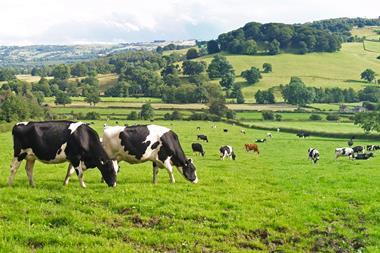NPD: TULIP GETS CREATIVE
Tulip is trailblazing development of bacon meal centres and innovative products at its new Vejle factory
The bacon fixture is dogged by inherent conservatism. Range reviews usually mean redesigning labels or packaging rather than looking closely at either the fixture or its contents.
Tulip International new product development director Bent Olesen is in charge of Denmark's first dedicated all species added value meat product development centre at its Vejle north site, which opened on November 15.
The aim of the £2m centre is to create new meat-based meal centres for retailers across Europe, using all the major species. In bacon, this will mean further developments of the Streakers and Rashers cooked rasher products. It will also see the team building new ideas for meal centres on the lines of its existing garnished Christmas gammon range.
Tulip already has 20 full time staff working exclusively on new product development (NPD) and many of the Danish staff will be brought together in the new centre.
"Let us be clear that we are not talking about relaunches, new labels, packaging or minor changes to an existing line. That is product adjustment and we already have staff in the factories who look after that," he says.
"We want to develop things which consumers remember eating as a child, but for which they lack either the time or the knowledge to cook at home. We are making a new tradition for them.
"Across the group we develop at least 100 completely new products a year, but of these maybe 35-40 will survive.
"The thing about marinades and cures is that you can develop 20 flavours. But you know that in practice only five or six will sell. But in advance there's no way of knowing which ones."
Adding value is the heart of what Olesen wants to achieve. On the home market, Tulip has launched Pålaecker, a selection of starters and snacks.
The range comprises 100g packs of simple charcuterie lines, such as sliced roast pork and sliced meatball mixture. But the outward simplicity of the range does not mean it was sold cheaply: "In Denmark, we found it was possible to launch the right product without discounting it."
The same is true of the Tulip-branded 200g meal centre range called Menuett, launched in July. The mild flavoured marinaded strips of meat chicken and pork at present are packed on a CAP line. The flavours are tame by UK standards tomato or barbecue chicken and paprika pork. "If we were to consider this for the UK, we'd probably look at curry or spicy recipes," says Olesen.
In Germany, new lines need to be bland to allow consumers to put the finishing touches. The Gourmetti range of sliced chicken breast fillets has three flavours: tomato, herbs and just plain, cooked chicken.
When the 150g CAP packs was launched in April, German buyers were very anxious that even the herb or tomato flavours would be too strong for the market. "But we let the consumer decide," says Olesen.
However, NPD does not come cheaply, as Olesen is quick to remind his UK audience. "We've not discounted our new lines in Denmark or Germany. We asked the proper price to start with," says Olesen.
As families of new products develop in one country, such as Gourmetti or Menuet, they are reviewed for a possible launch elsewhere.
Bacon may not be strong as a children's lunch box product, but children are active in the kitchen fairly young. "Our research shows that by the age of eight, kids are using microwaves as a regular thing."
The 110g six rasher packs, with a 50% yield, are priced at £2.29 against branded 220g packs. The CAP packs use a clip-down lid to make them resealable and allow opened packs to be stored for later use.
Starting with unsmoked streaks, later variants are likely to include smoked and possibly back later on. "We need to get consumers used to buying ready cooked bacon first," cautions Hayward.
"We need to get consumers used to buying ready cooked bacon first," cautions Hayward.
The arrival of cooked bacon lines will mean a crossover of curing and marinading techniques to ensure the right eating qualities. Once processors start adding value to other parts of the carcase, however, the input costs start to spiral.
To make a slicing product such as ham or a ham variant with consistent eating quality requires primals to be dismantled before the large muscles in a leg, for instance, can be assembled and cured. The remaining sinews and small muscles need a different treatment, hence the complementary development of charcuterie in France, salami and sausages across northern Europe.
For now, the British counterparts, pork pies,sausages and other small goods, fall short of offering a signicant counterweight to the demand for the backs that both bacon curers and fresh pork butchers need.
In the long term, the de facto establishment of a new category in cooked bacon, wherever it is merchandised in the store, will also mean redefining the sections in the fixture to make any analysis of the category workable, since uncooked bacon rashers are sold for a different set of meal occasions than the cooked counterparts.
{{FOCUS SPECIALS }}
Close menu
- Home
- Retail & Wholesale
-
Products & Suppliers
- Back to parent navigation item
- Products & Suppliers
-
Product Categories:
- Back to parent navigation item
- Product Categories:
- Alcoholic drinks
- Bakery
- Cereals & breakfast
- Cheese
- Chicken & poultry
- Chocolate
- Confectionery
- Crisps, nuts & snacks
- Dairy
- Fish
- Fresh produce
- Frozen
- Household
- Meat
- Own Label
- Sauces & condiments
- Seasonal
- Soft drinks
- Vaping
- Vegan & plant-based
- World foods
- Suppliers
- People
- Reports & Data
-
Topics A-Z
- Back to parent navigation item
- Topics A-Z
-
Popular topics:
- Back to parent navigation item
- Popular topics:
- Cost of living crisis
- Crime
- Deposit Return Schemes
- Finance
- Government & Regulation
- Health
- Inflation
- Loyalty
- Marketing
- Mergers & Acquisitions
- New Product Development
- Sourcing
- Supply chain
- Sustainability & environment
- Technology
- Ultra Processed Foods
- Vaping
- A-Z all topics
- Content by type:
- Events
- Subscribe now
Sign in to comment on this article
Not logged in before? Register for FREE guest access today.
You will be able to:
- Read more stories
- Receive daily newsletters
- Comment on stories
Advert
















No comments yet